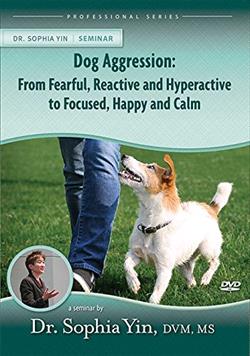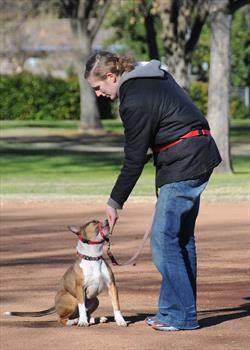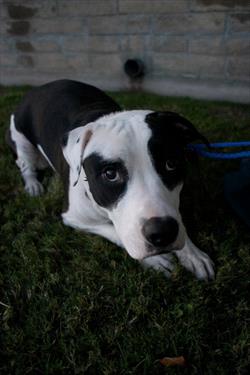You may know many techniques for dealing with your reactive or aggressive dog, but with many dogs, to get the results you want you need a clear step-by-step plan. First you need to realize that every interaction is a training session, so what you do outside of official sessions may undermine your progress. Second, for fast and enduring results it’s often essential to improve the dog’s impulse and emotional control. Third, your training will require good technique and an integrative approach and should focus on creating a dog who is happy, focused and calm.
In this engaging 3-hour seminar, veterinarian and applied animal behaviorist, Dr. Sophia Yin presents a comprehensive plan for helping fearful, aggressive or reactive dogs overcome their behavioral problems. You’ll see a number of different desensitization and counterconditioning techniques and learn when to use each one. You’ll see how to identify all sources of fear and impulsivity, and understand how these factors hinder progress. And due to the stepwise global nature, you’ll see dogs improving faster than you ever thought they could!
- Teaching Fido to Learn to Earn: Dr. Yin’s Program for Developing Leadership Skills in Humans and Impulse Control in Dogs
- Description
- Every pet needs a human who can lead, but not like a dictator, rather more like a partner in a dance. In this lecture Dr. Yin shows you a step-by-step way for building a strong, positive relationship. One that’s based on: understanding what motivates your dog, learning how to use all motivators to your advantage, and recognizing how to avoid accidentally rewarding unwanted behaviors. Her version of the Learn to Earn program teaches owners to set clear rules, communicate the rules through correct body language and timing of rewards, as well as provide an environment of more certainty and less stress for the pet. Dogs in turn learn impulse control, which is the root of a majority of behavior issues, and to look to their humans for guidance. Humans learn that training occurs with every interaction and by increasing their awareness can change their dogs’ behavior, virtually over night.
- Every pet needs a human who can lead, but not like a dictator, rather more like a partner in a dance. In this lecture Dr. Yin shows you a step-by-step way for building a strong, positive relationship. One that’s based on: understanding what motivates your dog, learning how to use all motivators to your advantage, and recognizing how to avoid accidentally rewarding unwanted behaviors. Her version of the Learn to Earn program teaches owners to set clear rules, communicate the rules through correct body language and timing of rewards, as well as provide an environment of more certainty and less stress for the pet. Dogs in turn learn impulse control, which is the root of a majority of behavior issues, and to look to their humans for guidance. Humans learn that training occurs with every interaction and by increasing their awareness can change their dogs’ behavior, virtually over night.
- Objectives
- Understand what leadership is and the two opposite approaches.
- Learn how a program based on rewarding desired behaviors, removing rewards for unwanted behaviors, and using all motivators to your advantage can improve your leadership skills and your relationship with your dog.
- Recognize how Dr. Yin’s Learn to Earn program teaches dogs to look to the owners for guidance and helps these dogs develop self-control.
- Learn the individual Learn to Earn exercises, how to apply them to new situations, and how to incorporate them into daily life so you can get huge changes virtually overnight.
- Realize that the largest source of unpredictability and uncertainty from a dog’s perspective can be how humans react or interact with them. Learn how to be clear and consistent in order to build a relationship based on communication and mutual understanding.
- Understand what leadership is and the two opposite approaches.
- Description
- An Integrative Approach to Dealing with Your Fearful, Reactive, or Aggressive Dog
- Description
- You may know many techniques for training your reactive or aggressive dog, but do you have a cohesive plan? Many people approach the situation narrowly by focusing only on the problem they see when many other factors contribute to their dog’s behavior and may affect his progress. This presentation provides an overview of how to recognize early signs of fear, why it can lead to aggression, and how unfamiliar people and dogs can make it worse. Dr. Yin presents a plan that takes an integrative approach – one in which you identify all sources of fear and impulsivity, and understand how these factors interact to exacerbate the situation and hinder progress. You’ll learn a number of different desensitization and counterconditioning techniques and when to use each one. Understand the importance of keeping your dog safe through careful planning and knowing emergency techniques.
- You may know many techniques for training your reactive or aggressive dog, but do you have a cohesive plan? Many people approach the situation narrowly by focusing only on the problem they see when many other factors contribute to their dog’s behavior and may affect his progress. This presentation provides an overview of how to recognize early signs of fear, why it can lead to aggression, and how unfamiliar people and dogs can make it worse. Dr. Yin presents a plan that takes an integrative approach – one in which you identify all sources of fear and impulsivity, and understand how these factors interact to exacerbate the situation and hinder progress. You’ll learn a number of different desensitization and counterconditioning techniques and when to use each one. Understand the importance of keeping your dog safe through careful planning and knowing emergency techniques.
- Objectives
- Recognizing common signs of fear and understand how unfamiliar people and dogs can accidentally make fearful dogs worse.
- Learn the core methods of behavior modification and how skill and an integrative approach are necessary for success in challenging cases.
- Realize why it’s important to stay out of problem situations and learn appropriate strategies for an emergency. See how easy it is to accidentally end up in an unsafe situation even when you have good behavior modification skills.
- Understand how a successful behavior modification plan requires an integrative approach that identifies all sources of fear and any situations where the dog may lack impulse control.
- Explore a variety of desensitization and counterconditioning methods and identify when to use each method.
- Recognizing common signs of fear and understand how unfamiliar people and dogs can accidentally make fearful dogs worse.
- Description





